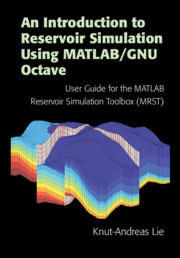 An Introduction to Reservoir Simulation Using MATLAB/GNU Octave
An Introduction to Reservoir Simulation Using MATLAB/GNU Octave Book contents
- Frontmatter
- Contents
- Preface
- 1 Introduction
- Part I Geological Models and Grids
- Part II Single-Phase Flow
- Part III Multiphase Flow
- 8 Mathematical Models for Multiphase Flow
- 9 Discretizing Hyperbolic Transport Equations
- 10 Solvers for Incompressible Immiscible Flow
- 11 Compressible Multiphase Flow
- 12 The AD-OO Framework for Reservoir Simulation
- Part IV Reservoir Engineering Workflows
- Appendix The MATLAB Reservoir Simulation Toolbox
- References
- Index
- Index
10 - Solvers for Incompressible Immiscible Flow
from Part III - Multiphase Flow
Published online by Cambridge University Press: 22 July 2019
- Frontmatter
- Contents
- Preface
- 1 Introduction
- Part I Geological Models and Grids
- Part II Single-Phase Flow
- Part III Multiphase Flow
- 8 Mathematical Models for Multiphase Flow
- 9 Discretizing Hyperbolic Transport Equations
- 10 Solvers for Incompressible Immiscible Flow
- 11 Compressible Multiphase Flow
- 12 The AD-OO Framework for Reservoir Simulation
- Part IV Reservoir Engineering Workflows
- Appendix The MATLAB Reservoir Simulation Toolbox
- References
- Index
- Index
Summary
This chapter teaches you how to simulate incompressible, two-phase flow using a sequential formulation that splits the equation system into an elliptic pressure equation and a hyperbolic (or parabolic) saturation equation. We discuss fluid objects, the sequential solution procedure, and explicit and implicit transport solvers in some detail. The second part of the chapter is devoted to a number of simulation examples that highlight typical flow behavior. Examples include gravity segregation, homogeneous quarter five-spots, heterogeneous quarter five-spots with viscous fingering, and buoyant migration of CO2 in a sloping aquifer. Furthermore, we discuss water coning, gravity override, capillary fringes, and a simplified simulation of the Norne field model. We end the chapter by a discussion of various sources of numerical errors, including splitting and grid-orientation errors.
Keywords
Information
- Type
- Chapter
- Information
- An Introduction to Reservoir Simulation Using MATLAB/GNU OctaveUser Guide for the MATLAB Reservoir Simulation Toolbox (MRST), pp. 289 - 336Publisher: Cambridge University PressPrint publication year: 2019
- Creative Commons
- This content is Open Access and distributed under the terms of the Creative Commons Attribution licence CC-BY-NC-ND 4.0 https://creativecommons.org/cclicenses/